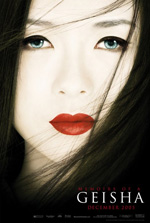AUTHENTICITY OF A GEISHA

The Bluest Eye
Every single woman from Japan I've spoken to recently has expressed fears about authenticity and cultural accuracy in the new film, Memoirs of a Geisha. In response, I told my mother she needed to loosen the obi around her kimono.
Why worry? Hollywood has been good to the Japanese. Karate Kid 2. Rising Sun. The Last Samurai. Mr. Baseball. These are anthropological gems showcasing detailed intricacies of Japanese society that would wet a historian's bed.
Memoirs is likely to be especially accurate since it is directed by Japanese auteur Rob Marshall, based on the novel by Japanese historian Arthur Golden, and starring Japanese actors Ziyi Zhang, Michelle Yeoh, and Gong Li. Moreover, the film's make-up artists also consulted historical sources to ensure that the eyes of the Japanese characters contained the proper tint of blue, as evidenced by the poster above.
Even if a few "outsiders" were involved in the making of Memoirs, the Japanese should take comfort in the fact that Hollywood has always placed a premium value on accuracy in portraying other cultures.
Disney, for example, always does painstaking research to ensure authenticity. In the historical biopic Pocahontas, the writers made sure to accurately portray the sacred ritual of all Native Americans singing to mischievous raccoons about the colors of the wind. Of course, this cultural exactitude was not achieved in the similarly-titled movie about Native Americans called Pocahotass, although, in its defense, it did faithfully reenact the attack on the Semenhole Tribe.
Regardless, once the world sees Memoirs, with its cast decked out in authentic fur kimonos, everyone will undoubtedly absorb the truth that all Japanese women are geishas who speak broken English (and all Japanese men are ninjas).
*
Update: read my actual film review here.

<< Home